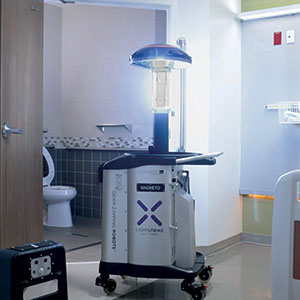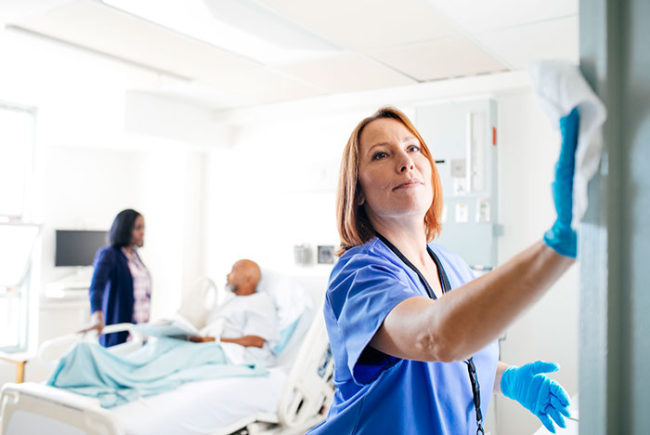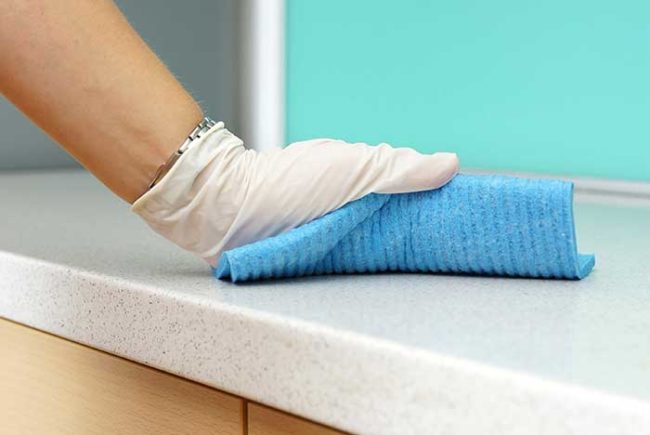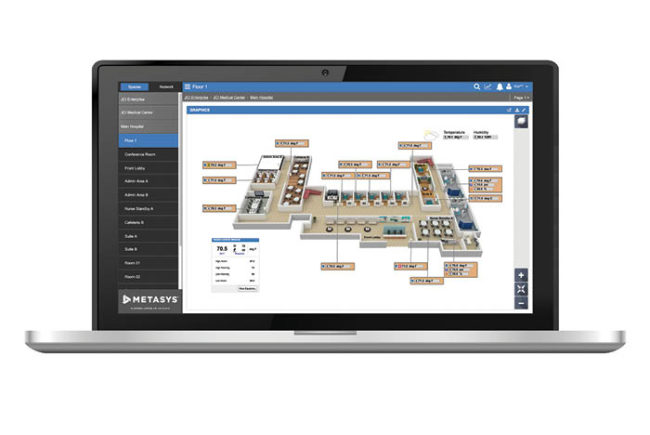Manufacturers of ultraviolet (UV) and hydrogen peroxide (HP) disinfection systems continue to upgrade their systems to meet the specialized needs of hospitals. In addition, applications are increasing and spreading to other areas of the hospital.
You may also like |
| Hospitals lay battle plans to fight pathogens |
| UV light disinfection heats up at APIC |
| Medical center cuts infection rates with UV |
|
|
No-touch enhanced disinfection methods have become commonplace in the past few years for two reasons, says Chuck Dunn, president and CEO, Tru-D SmartUVC LLC, Memphis. “First, hospitals face Medicare reimbursement cuts for the number of patients who are affected by health care-associated infections (HAIs) or for readmissions. Second, a recent large-scale, multisite, Centers for Disease Control and Prevention (CDC)-funded, randomized clinical trial concluded that a combination of manual cleaning and measured-dose UV light results in a 30 percent reduction of infections for patients who stay in rooms previously occupied by infected patients.”
David St. Clair, chairman, Halosil International Inc., New Castle, Del., says that since the Halo Disinfection System (HDS) received the Environmental Protection Agency’s whole-room surface disinfection label for a 99.9999 percent kill of Clostridium difficile spores in 2013, the company has seen market adoption rise dramatically. The HDS is now distributed to health care facilities nationwide and internationally.
As UV and HP delivery technologies and services continue to evolve and facilities continue to track the incidence of infections, the usage patterns for these devices will be redefined, experts agree.
Range of innovations
Among a wide range of new product innovations, Halosil has introduced the HaloFogger FLX, which features a detachable nozzle. This allows the system to remain outside the room during fogging. Upon completion of the fog application for one room, the hoses can be detached, another set attached, and the HaloFogger moved to the next room to be treated. This allows for faster room turnaround and saves money.
Surfacide LLC, Naperville, Ill., has developed a triple-emitter UV-C disinfection system. Because UV disinfection is a direct-line-of-site modality, multiple emitters minimize shadows and reduce the distance to surfaces, the company states. This allows the Surfacide system to deliver more energy in less time with less labor, according to Adam Buchaklian, Ph.D., director of clinical research.
Tru-D SmartUVC LLC offers the Total Room Ultraviolet Disinfection robot, a mobile room air and surface disinfection unit. The remote-controlled device is designed for operating rooms (ORs), patient rooms and areas that require quick turnaround. Sensors on the unit monitor the amount of light that is reflected from various areas in the room, identify the area from which they detect the least reflected light, and automatically adjust the cycle time to ensure that the area receives the required amount of UV light for the chosen cycle.
With its Sensor360 technology, Tru-D is able to overcome room variables such as size, shape and content to deliver a precise, lethal dose of UV light to eliminate up to 99.9 percent of pathogens. The system operates from a single position and administers a single cycle of UV light to provide total room disinfection. “UV disinfection robots such as [those made by] Tru-D SmartUVC are commonly used in patient rooms and most notably isolation discharge rooms, eliminating pathogens left behind by infected patients,” Dunn adds.
Xenex Disinfection Services, San Antonio, Texas, manufactures germ-
zapping robots that use pulsed xenon (not mercury) to create UV light. Because pulsed xenon is powerful, the robots are capable of disinfecting rooms in minutes. Also, no warm-up or cooldown is required between cycles, so the robots can treat many rooms each day, according to Daniel English, environmental services principal.
Xenex robots quickly destroy the microorganisms that cause HAIs, such as C. difficile, methicillin-resistant Staphylococcus aureus (MRSA) and the Ebola virus. They work by using pulsing xenon, an inert gas, at high intensity in a UV flash lamp. This produces UV-C, which penetrates the cell walls of microorganisms including bacteria, viruses, mold, fungus and spores. Their DNA is instantly fused so they are unable to reproduce or mutate, effectively killing them on surfaces and in the air without contact or chemicals.
Steris Corp., Mentor, Ohio, has developed the Pathogon UV Disinfection System and the VaproQuip Decontamination Room. Pathogon is used for routine UV-C disinfection of patient rooms and OR suites following terminal cleaning. It also is used in intensive care units, isolation rooms and other areas where risk of cross-contamination is a threat to patients, visitors and staff.
The VaproQuip Decontamination Room injects 35 percent vaporized HP (using a completely dry process) into a specially constructed 12-foot-by-12-foot or 12-foot-by-16-foot room that is installed within a health care facility. “This represents a unique approach to driving consistency in the decontamination of reusable medical equipment, such as patient beds, wheelchairs, IV stands, sequential compression devices and commodes. Having a dedicated room eliminates the need for repeated setup in individual patient rooms — as is required when using an in-room hydrogen peroxide fogger,” says Doug Goldman, senior product manager.
Among manufacturers providing measurable results showing the success of their disinfection systems, Halosil International reports that a Pennsylvania Hospital reduced C. difficile infection rates by 66 percent by using its Halo disinfection system.
Surfacide reports that Faxton St. Luke's Healthcare, Utica, N.Y., achieved a 41 percent reduction in its hospital onset C. difficile rates during the first year of system use, which resulted in $1.4 million direct cost avoidance.
Xenex robots have helped health care facilities in the U.S. to decrease their MRSA, C. difficile and surgical-site infection rates by 50, 70 and 100 percent, respectively, according to peer-reviewed literature, the company reports.
Clean machines
The wide acceptance of UV and HP technology in wheeled-in devices also has resulted in a number of other products using these technologies.
Kenall Manufacturing, Kenosha, Wis., has developed a lighting fixture product called Indigo-Clean, which continuously disinfects the hospital environment with safe, visible light. Unlike UV light that requires the room to be taken out of service, Indigo-Clean can disinfect while people are in the room performing tasks that require high visual acuity, such as surgery. The product has been in university development since 2002 and the subject of more than 30 refereed publications and conference proceedings since 2008, says Cliff Yahnke, director of clinical affairs.
“Indigo-Clean was launched in 2015 at the Association for Professionals in Infection Control and Epidemiology annual conference in Nashville. It has been deployed with a select number of clinical partners in the U.S., including the Medical College of Wisconsin and United Hospital–Kenosha Medical Center Campus with more to be announced over the next few months,” he adds.
Disinfecting hospital equipment is another area of product innovation. The Hubscrub Co., Manchester, N.H., offers Model 20/80-UV, which uses UV technology to clean and disinfect a variety of equipment. Wheelchairs, commodes and other patient care equipment can be cleaned thoroughly using less than four gallons of water. Once clean, UV disinfection is activated to C. difficile levels in less than six minutes. The device requires standard electrical power, hot tap water access and a place to drain.
“The availability of an automated system for patient-care equipment using UV disinfection offers many advantages,” says Karl Soderquist, Hubscrub president. “The equipment is placed in an enclosed unit with much smaller dimensions than a patient room, so disinfection cycles are quicker because there is less distance between the UV light and equipment. According to independent testing, ‘the combination of wash cycle and UV cycle resulted in complete reduction of all tested pathogens from steel disk carriers. Pathogens included C. difficile, MRSA and carbapenem-resistant Enterobacteriaceae from wheelchairs.’”
Advanced Ultra-Violet Systems, South Hill, Va., has introduced the AUVS KR615 Germicidal Enclosure that reportedly addresses two significant problems in health care. The first is infection prevention by sanitizing small, mobile devices. The other is preventing damage to expensive medical equipment caused by infection prevention efforts.
The KR615 is designed to fill a gap in a hospital’s infection prevention protocol — specifically targeting small, high-touch medical devices that move freely around the hospital, and are known agents of cross-contamination. These items include stethoscopes, glucose meters, cellphones, small tablets and blood pressure cuffs. Typically, they are not in the room during terminal cleaning with disinfecting robots.
After equipment is placed inside the KR615 enclosure, the UV-containment door is closed and the touch of a button starts a 48-second sanitizing cycle. Even devices that need to remain plugged in or connected with leads can be sanitized, thanks to the unit’s wire routing feature. Because the KR615 is an enclosure, safely containing UV light, it can be used in a variety of hospital settings.
“In addition, the system will not damage expensive medical equipment,” says CEO Jim Psihas. “The use of bleach-based wipes and sprays can render a hospital’s other devices unusable — especially devices with LED screens that can be clouded and made unreadable by such cleaning practices. This damage can cost hospitals $100,000 a year or more by shortening the service life of many devices.”
The right choice
Facilities managers need to consider many factors when purchasing an automated disinfection system. But two are most important, according to manufacturers that supply the nation’s hospitals. The first is efficacy or how well the system can actually disinfect a space. The second is how much labor is required to utilize the system effectively. Other important questions to ask: Has the technology been proven to reduce infections? Have the data been validated via peer review?
“When hospitals consider a UV disinfection system, they need to carefully evaluate the technology’s clinical outcome studies — peer-reviewed studies that show how a hospital has experienced a decrease in infection rates after using a UV disinfection system,” Xenex’s English says.
In addition, facilities managers should ask vendors about the implementation and training they provide to ensure infection-reduction success.
“Xenex, for example, sends in an implementation team to work with the hospital’s environmental services and infection prevention staff to determine the optimum protocol for running the robots,” according to English. “Xenex
also trains the employees who run the robots. Hospital administrators are given access to a portal where they can review robot usage in real time, and measure their HAI-reduction benchmarks.”
Neal Lorenzi is a freelance writer based in Mundelein, Ill.
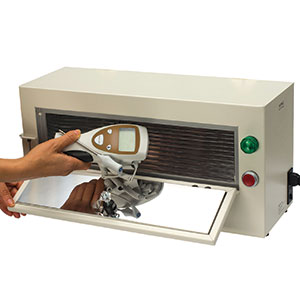
Micro solution
The AUVS KR615 is proven to sanitize 99.9 percent of contaminants, including Clostridium difficile and MRSA, in 48 seconds. Advanced Ultraviolet Systems
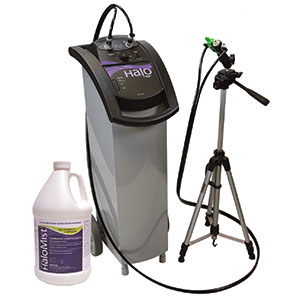
Hands-free
The HaloFogger FLX, used with HaloMist disinfectant, provides an EPA-registered, no-touch kill of 99.9999 percent of C. difficile spores in a whole room and facilitates fogger placement outside the treatment area to speed the process. Halosil International Inc.
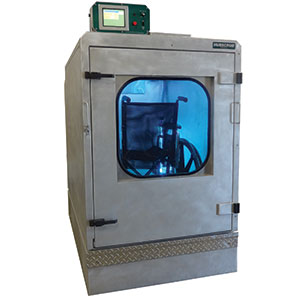
Scrub in
The Model 20/80-UV uses UV technology to clean and disinfect a variety of hospital equipment, including wheelchairs. The Hubscrub Co.
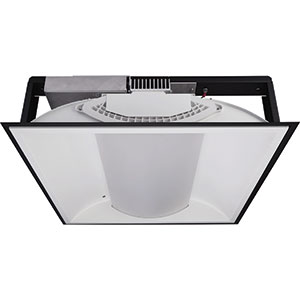
Continuous clean
Indigo-Clean can continuously disinfect the hospital environment with safe, visible light. Kenall Manufacturing
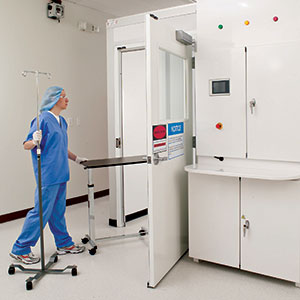
Total package
The VaproQuip Decontamination Room is designed to enable decontamination of clean, dry, noncritical equipment, furniture and environmental surfaces using the VHP generator and Vaprox 35 percent Hydrogen Peroxide Sterilant. Steris Corp.
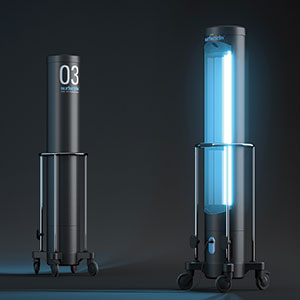
Three in one
This system uses three emitters, which reduces UV-C disinfection time, minimizes shadows and uses less labor to operate. Surfacide LLC
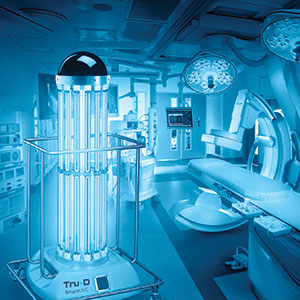
Hit every corner
This system uses a patented Sensor360 technology to provide total room disinfection. Tru-D SmartUVC LLC
